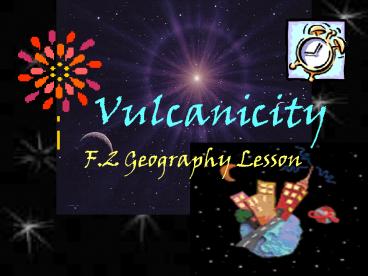Vulcanicity - PowerPoint PPT Presentation
1 / 42
Title:
Vulcanicity
Description:
Magma beneath the crust forces its way to the lines of weakness. Line of weakness ... Magma. The magma reaches the Earth's surface through the lines of weakness ... – PowerPoint PPT presentation
Number of Views:671
Avg rating:3.0/5.0
Title: Vulcanicity
1
Vulcanicity
- F.2 Geography Lesson
2
(No Transcript)
3
Contents
- The formation of a volcano
- Types of volcanoes
- The distribution of volcanoes
- The hazards and benefits of vulcanicity
- Questions
- Activity Making a paper volcano model
4
The formation of volcanoes
5
The formation of volcanoes
Line of weakness
Magma beneath the crust forces its way to the
lines of weakness
6
The magma reaches the Earths surface through the
lines of weakness which is then called lava
Layers of lava
Magma
7
Lava cools and forms hill called volcano
8
Now, you can take a look at the whole
process(automatic animation) once again.
9
(No Transcript)
10
(No Transcript)
11
(No Transcript)
12
(No Transcript)
13
(No Transcript)
14
Types of Volcanoes
extinct
dormant
active
15
Types of Volcanoes
Extinct Volcanoes
-Volcanoes which haven't erupted since recorded
history and show no signs of ever erupting.
e.g. Kohala, Hawaii
16
Types of Volcanoes
Dormant Volcanoes
-Volcanoes that have not erupted in historic time
but probably will erupt again.
e.g. Mauna Kea, Hawaii
17
Active Volcanoes
Types of volcanoes
-Volcanoes that have erupted in historic time.
-e.g. Mount St. Helens
Hualalai
18
Do you know where do my friends live? My
friends live all over the WORLD!!
Asia
North America
Atlantic Ocean
Africa
Pacific Ocean
Indian Ocean
South America
Australasia
Click here to continue.
19
ASIA
Mt. Fuji ? A dead volcano ? Japan's highest and
most noted volcano ? Its growth began with a
period of voluminous lava flows from 11,000 to
8,000 years before present (BP) ? The last
eruption in 1707 ejected andesitic pumice and
formed a large new crater on the east flank.
20
North America
Mt. Adams ? a dormant volcano ? one of the
largest volcanoes in the Cascade Range
21
AUSTRALASIA
Mt. Krakatoa ? an active volcano ? the eruption
in 1983 caused a large damage on human lives
and property. ? frequent eruptions since 1927
22
South America
Mt. Cotopaxi ? one of the most active in the
world ? most well-known volcano ? the most
violent historical eruptions took place in 1744,
1768, and 1877. ? The last significant eruption
took place in 1904.
23
Africa
Mt. Etna ? an extinct volcano ? has the world's
longest documented record of historical
volcanism ? Historical lava flows cover much of
the surface
24
The hazards of vulcanicity
- 1. Release of poisonous gases
Photos showing the emission of poisonous
gases from the volcanoes.
25
The hazards of vulcanicity
2. Fire hazards
A photo of a fire hazard caused by volcanic
eruption in the Philippines, 1995.
26
The hazards of vulcanicity
3. Destruction of forests and farmlands
Forests were destructed by the eruption of
volcanoes in Malaysia.
27
The hazards of vulcanicity
Im very powerful!! hehe
4. Earthquakes
Destructions caused by earthquake
28
The hazards of vulcanicity
5. Tsunamis
Tsunami in Hawaii in 1906
29
The benefits of vulcanicity
1. Tourist Attractions
Beautiful Fuji (above) and Aso volcano (right)
30
The benefits of vulcanicity
2. Fertile soil
Basic lava gives fertile soil.
31
The benefits of vulcanicity
3. Mineral deposits
sulphur
gold
copper
Volcanic rocks contain mineral deposits
32
The benefits of vulcanicity
4. Geothermal Electricity
A power-generating plant using geothermal energy
33
Hey, here comes the question time!
1. Which of the following types of volcanoes
can erupt ? I. extinct volcanoes II.
dormant volcanoes III. active volcanoes
A. I only. B. III only C. II and III. D.
All of them
34
2. Which of the following countries lie
within volcanic belt?
I. Japan II. The Philippines III. England IV.
Indonesia
A. I only. B. I, II, IV. C. None of them.
D. All of them.
35
3. Which of the following substances will be
emitted during volcanic eruption?
I. Water vapours. II. Poisonous gases. III.
Lava. IV. Mineral substances.
A. III only. B. II and III. C. I, II and III.
D. All of them.
36
4. Which of the following hazards are
associated with volcanic activities?
I. Typhoons II. Earthquakes III. Drought IV.
Landslides
A. II only. B. IV only. C. II and IV. D.
All of them.
37
5. Why do people still prefer to live in the
volcanic regions?
I. Scenic spots. II. Volcanic eruptions are
not frequent. III. Lower population density. IV.
Lava gives fertile soil.
A. III only. B. I and IV. C. I, II
and IV. D. All of them.
Click here to continue.
38
Sorry, your option is incorrect. Please try again.
39
Congratulations! Your option is correct.
40
Activity Making a paper volcano model
Click here to have a closer view
41
Now you all know more about me
and my family. Enjoy your lesson!!
Happy volcano!!! Bye bye.
42
- Group Member
- Wan Wing Sze (Tracy) s995978
- Chan Ka Ming (Jenny) s996281
- Lee Wun Yee (Winnie)s997663
- Tang Wing Hang (Andy)s996403
- Chan Siu Wun (Betty) s997750

